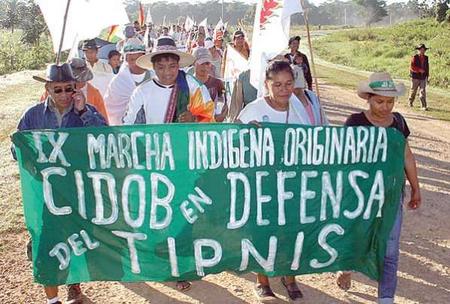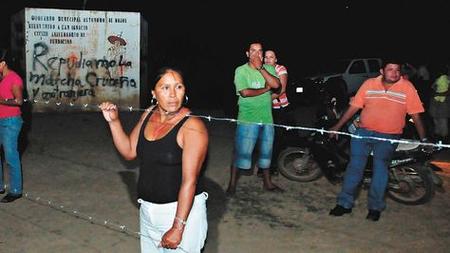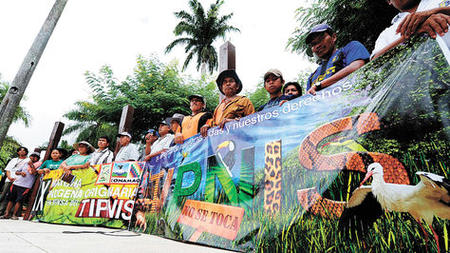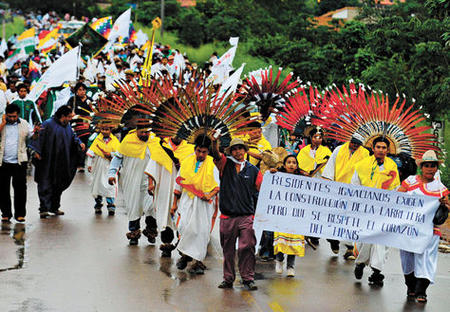The second indigenous march in defense of Bolivia’s Isiboro-Sécure Indigenous Territory and National Park (TIPNIS) reached San Borja this past weekend, completing one-third of its 370-mile trek to La Paz. Both the route and the litany of physical hardships endured by the marchers have evoked strong memories of last year’s mobilization, which forced the government of President Evo Morales last October to call a halt (albeit temporarily) to the proposed highway that would bisect the reserve.
Yet, the political climate in which this second march is taking place is very different from what it was seven months ago, and whether the success of the first march can be replicated today remains an open question.
 Some 400 marchers arrived in San Borja last Friday (as compared to 1,700 in September 2011). Around a dozen indigenous organizations from inside and outside the TIPNIS are officially represented. A unique characteristic of this march, according to its president Bertha Bejarano, is that many individuals are participating independently of any organizational affiliation. At least 100 additional marchers are expected to join in the next couple of days.
Some 400 marchers arrived in San Borja last Friday (as compared to 1,700 in September 2011). Around a dozen indigenous organizations from inside and outside the TIPNIS are officially represented. A unique characteristic of this march, according to its president Bertha Bejarano, is that many individuals are participating independently of any organizational affiliation. At least 100 additional marchers are expected to join in the next couple of days.
Along the route, the marchers have encountered a mixed reception. In San Ignacio de Moxos, a barbed wire barricade constructed by pro-road union sectors forced the march to detour around the community. In San Borja, residents greeted the marchers enthusiastically with festivities and provisions, although the government party Movement Towards Socialism (MAS) mayor did not provide an official welcome.
The momentum of the second march has been weakened by several factors. The Morales government’s decision to proceed with a community consultation process on the road, though regarded by TIPNIS protesters as “after the fact” and illegitimate, succeeded in putting the march on the defensive before it began, especially after the construction contract with Brazil’s OAS was cancelled.
Divisions within and between lowland indigenous groups around the march and the consulta have intensified in recent months, due in part to a concerted government campaign to win support through delivery of benefits and promises to local communities. Just last week, Chief of Staff Juan Ramón Quintana announced the start of a free water taxi service on the three major rivers that traverse the TIPNIS, which serve as its principal transportation route. These and similar enticements have divided many TIPNIS communities into pro-government and pro-march factions, with contested leadership.
The government has also signed bilateral agreements with at least eight of 13 regional affiliates of the Confederation of Indigenous Peoples of Bolivia (CIDOB), the lowlands federation that is sponsoring the march. These organizations are now challenging the legitimacy of Adolfo Chávez, CIDOB president, who continues to lead the march with the support of dissident CIDOB factions.
Chávez, in turn, has signed a community development agreement with opposition governor Rubén Costas of Santa Cruz, an act which has been sharply criticized by lowland indigenous leaders such as Fernando Vargas, president of the TIPNIS Subcentral. Vargas, a key leader of the first TIPNIS march, has been largely absent from the second march due to illness, another factor that has contributed to its weakened momentum.
With these new tactics, the Morales government seems to have regained the upper hand in the TIPNIS conflict. It has also claimed the moral high ground by insisting (contrary to its approach during the first TIPNIS march) that the protesters have a right to march that is constitutionally protected.
At the same time, the government has revived its previous strategy of seeking to undermine the march by discrediting, isolating, and criminalizing its leaders and supporters. At San Ignacio, Vice Minister Jorge Pérez, who arrived to guarantee the marchers’ safe passage, took advantage of the opportunity to assure the blockaders that the marchers were participating for financial, not principled, motives. Government officials have renewed claims that TIPNIS leaders, including Vargas, have engaged in illegal wood trafficking, activities which those accused either deny or claim were part of approved forest management plans.
 Additionally, the government has formally charged opposition deputy Marcela Revollo with sedition and seeking to destabilize the government by financing the TIPNIS march—through the sale of five-boliviano (70-cent) photo cards in a non-profit fundraising effort, she claims. While these manipulative tactics largely backfired the first time around, in the current political climate they may have more resonance.
Additionally, the government has formally charged opposition deputy Marcela Revollo with sedition and seeking to destabilize the government by financing the TIPNIS march—through the sale of five-boliviano (70-cent) photo cards in a non-profit fundraising effort, she claims. While these manipulative tactics largely backfired the first time around, in the current political climate they may have more resonance.
A significant difference between the first and second TIPNIS march is the environment of intense social conflict, especially in the urban areas, that currently prevails in Bolivia. 2012 has seen almost continuous (and sometimes violent) protests, marches, strikes, and blockades in the major cities, spearheaded most recently by doctors and health care workers protesting a forced increase in working hours along with parallel mobilizations by university sectors, transportation workers, police officers, and the Bolivian Workers Central (COB).
The significance of these multiple protests, and their potential impact on the TIPNIS conflict, is open to debate. While recurring protests are not unusual in Bolivia, these have lasted longer than in previous years of the Morales government—though their focus is primarily on sectoral demands and not on challenging Morales or the MAS, whose political dominance remains firmly entrenched.
According to Vice President Alvaro García Linera, these conflicts reflect “creative tensions” in a democratic society over the distribution of expanding economic resources, which the government is successfully managing. Some government critics also concur that the government may be the ultimate beneficiary of a permanent state of disparate conflicts that it can control, which serve to distract from more fundamental problems.
On the other hand, analyst Roger Cortez argues that protracted multiple protests can lead to a state of ungovernability, especially when the government—through provocation, failed initiatives, or mismanagement—is perceived as a major cause of the conflict. As a case in point, many believe that the Morales government could have avoided the TIPNIS controversy by implementing the required consultation process in a timely manner in the first place, and has exacerbated the conflict by the tactics it has pursued.
To date, the main effect of the plethora of urban protests on the TIPNIS conflict has been to distract media and popular attention from the indigenous march. Despite sporadic expressions of solidarity from the COB and other urban sectors, the “indigenous-urban alliance” envisaged by some TIPNIS leaders has not (yet) materialized. The government has defused the health sector conflict, at least for now, by withdrawing its controversial decree mandating a longer workday, and seems to be resolving or marginalizing other key disputes. This makes it less likely that the TIPNIS march can serve as a catalyst to unite a multiplicity of discontents, though the situation remains volatile.
As ex-MAS governor Rafael Puente observes, the real danger of prolonged, entrenched conflicts is the damage they inflict on the social-political fabric. The TIPNIS conflict in particular, he argues, has created a logic of confrontation between social sectors that should be allies and a destructive dynamic of community manipulation and dubious alliances in which both government and indigenous protesters participate. “The TIPNIS conflict,” he laments, “shows us how far we are from ‘decolonizing’ the (Bolivian) state, and civil society.”
As the TIPNIS march advances towards La Paz, it is a sobering conclusion worth pondering.
Read more on the TIPNIS conflict on Emily Achtenberg's blog, Rebel Currents. See also, the January/February 2011 NACLA Report, "Golpistas! Coups and Democracy in the 21st Century;" the September/October 2010 NACLA Report, "After Recognition: Indigenous Peoples Confront Capitalism;" or the September/October 2009 NACLA Report, "Political Environments: Development, Dissent, and the New Extraction." Or subscribe to NACLA.

